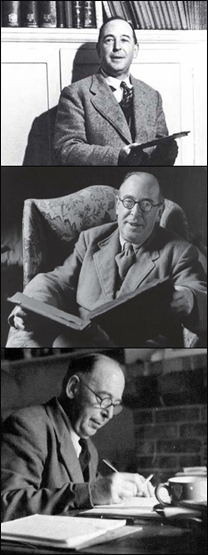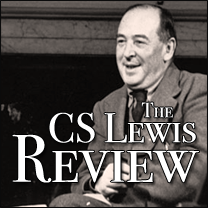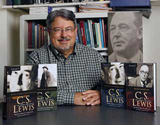
Story as Truth
April 12th, 2014 | Skip to comments
Rebecca Au
 Rebecca Au is a twenty-year-old studying Media, Culture, and the Arts at The King’s College in New York City. She is a question-asker, letter-writer, and joy-seeker who straightens crooked punctuation in her spare time. rebeccasau.tumblr.com
Rebecca Au is a twenty-year-old studying Media, Culture, and the Arts at The King’s College in New York City. She is a question-asker, letter-writer, and joy-seeker who straightens crooked punctuation in her spare time. rebeccasau.tumblr.com
“Those forms in which everything is there for the sake of the story have been given little serious attention. Not only have they been despised, as if they were fit only for children, but even the kind of pleasure they give has, in my opinion, been misunderstood,” writes C.S. Lewis in his essay “On Stories” (On Stories 3) This piece, along with fellow Inkling J.R.R. Tolkien’s essay “On Fairy-Stories,” serves to defend the value of imaginary stories. Lewis reveals in much of his fiction how he’s taken this literary theory to heart. Lewis constructed stories that were not solely fit for children, not merely for the sake of excitement, and not a rejection of reality. Instead, he wielded the power of story to reveal spiritual truth and to sharpen readers’ view of eternity.
Tolkien’s essay addresses the claim that stories are child’s fantasies, or an escape from the real world. To those who view this present material world as the primary reality, storytellers such as Lewis are like Puddleglum, declaring that “the made-up things seem a good deal more important than the real ones. … I’m on Aslan’s side even if there isn’t any Aslan to lead it” (The Silver Chair 182). Tolkien questions if Escapism is so wrong after all: desertion from our duty to reality is one thing, but escape from a prison to our true home is another.
Lewis presents characters who pose similar concerns about the validity of stories. In The Voyage of the Dawn Treader, Eustace teases his cousins Lucy and Edmund for their conversations about Narnia, dismissing their accounts as made up. Having read only books of information, Eustace lacks imagination and rejects whatever is not strictly factual. The Fox of Till We Have Faces is another character who shuns stories. His Greek wisdom classifies the myths of pagan religion as only the “lies of priests and poets” (Till We Have Faces 303). As a result, he finds natural explanations for circumstances that others believe to be caused by the gods. To the Fox, the change in weather after Psyche’s sacrifice is a coincidence brought by the forces of weather, and Psyche’s palace has been built from her fantasies, her thirst, and her terror.
For both of these characters, stories are childish. But according to Lewis’s depiction, Eustace and the Fox condemn what they do not understand. Eustace does not approve of story-telling because “he was far too stupid to make anything up himself.” The Fox confesses by the end of Till We Have Faces that despite his “prattle of maxims” (Till We Have Faces 295) that taught that the gods did not exist, there was much he did not know. Neither of these instances necessitate that the myths are wholly true, but they submit that there is something real in them. Imagination is a legitimate part of the world. Psyche wonders at the same possibility: “I have come to feel more and more that the Fox hasn’t the whole truth. . . . They are real gods but don’t really do these things. Or even – mightn’t it be – they do these things and the things are not what they seem to be? How if I am indeed to wed a god?” (Till We Have Faces 71).
Lewis and Tolkien believed that Story not only valuable, but true. The whole premise of the Chronicles of Narnia is of real human children’s interaction with worlds they did not make up. Early on in the Chronicles, Lewis answers the concern that Narnia is only make-believe when Susan and Peter confront Lucy’s report that she has entered Narnia. The older siblings discover that the most logical, though perplexing, response is to assume that she is telling the truth. Later Lewis even suggests that the “stories” are more real than everyday life: when carried to England, the witch Jadis and the Narnian apple both appear brighter and stronger than the normal things around them. At the end of the old Narnia, because Susan grew to conceive Narnia as only a “funny game” they played as children (The Last Battle 154), she is not beside the others who served and fought throughout Narnian history.
But if Narnia – and by extension, Story – is not just a game or pretense, what is it? Certainly, it is enjoyed for more than the excitement of its plot. In “On Stories,” Lewis proposes that besides the active narrative, there are elements of landscape and character that contain the meaning of the story. Authors purposefully select these to convey nuances of nature, humanity, or the spiritual world. A book such as The Great Divorce is an apt example of this distinction between what happens in the story and what the story is about. Plot-wise, The Great Divorce concerns a bus drive from a ghostly world to a bright and solid one where a myriad of conversations take place. That storyline enables us to apprehend the theme, that of the choice between self and God, damnation or redemption – a decision with eternal consequences. As Lewis writes, “the plot … is only really a net whereby to catch something else” (“On Stories” 17).
The principle that Story conveys spiritual reality holds true through Lewis’s fiction. In Perelandra, the landscape of the planet is significant to the theme, as Tinidril’s acquiescence to the flow of the waves parallels her trust in the will of Maleldil. The fixed land holds the appeal of surety and self-reliance, the same temptation that the Unman holds before Tinidril. And during the course of Narnia’s history, dwarves are depicted as practical, down-to-earth creatures, which coincides with their fondness for dwelling close to the ground. At their worst, they rally by the materialistic motto that the Dwarves are for the Dwarves (Prince Caspian 169, The Last Battle 83), and refuse to believe what they cannot touch or see.
Lewis tells us that the essence of the story may sometimes elude us in the tension between plot and theme, but the same occurs in life, where the “day-to-day details” are an imperfect net for catching “grand ideas” (“On Stories” 19). Yet when handled well, stories allow the “permanent and fundamental” (Tolkien 77) to show more clearly, recovering wonder in what we find familiar and ordinary. They are like Psyche, whose presence made the mud beautiful. Lucy and Edmund encounter this truth at the end of The Voyage of the Dawn Treader, when they are instructed to know Aslan by his other name on earth. “This was the very reason why you were brought to Narnia,” the Lamb tells them, “that by knowing me here for a little, you may know me better there” (The Voyage of the Dawn Treader 247). In Narnia, where the theme of the story is more visible, they came to love Aslan; on earth, as adults, they must continue to follow him. Eustace provides an example of how the children’s involvement in Story has transferred to their lives, for the beginning of The Silver Chair introduces us to a kinder, more courageous boy, who’s been changed by his adventures in Narnia.
The highest form of stories, Tolkien relates, are the ones that present eucatastrophe, the sudden turn to a happy ending after failure seemed inevitable. This is because in the incarnation, death, and resurrection of Christ, myth became fact. “Art has been verified. . . Legend and History have met and fused” (Tolkien 84). In this, legends and stories have been “hallowed” (Tolkien 84). Though we could stand like Puddleglum willing to side with Aslan even if he does not exist, we can rejoice that goodness is also powerful. Requited hope, the happy ending of the fairy-tale, can really happen for us. “I should object very strongly to describing God as a ‘fact,’” a ghost in The Great Divorce declares (The Great Divorce 42). But God, and the spiritual realities captured in tales, have already leapt from stories to invade our real world. We cannot simply contemplate these ideas – we must live them out in our actions and attitudes.
The characters from the Chronicles who were faithful to Aslan and took the stories as truth at last found themselves in the new Narnia beside the hosts of believing Narnians. They discovered that “our own world, England and all, is only a shadow or copy of something in Aslan’s real world” (The Last Battle 195), and that heaven is “deeper, more wonderful, more like places in a story” (The Last Battle 196). Our enjoyment of stories too, rather than distracting from life, can renew wonder in the everyday, as plot and theme together present an image of the gospel.
May God grant us eyes to see the Story – the adventure and the hope – that He is weaving in our lives.
Works Cited
Lewis, C.S. On Stories and Other Essays on Literature. 1966. Ed. Walter Hooper. New York: Harcourt Brace Jovanovich, 1982. Web. 27 Apr. 2012.
—. The Great Divorce. 1946. New York: HarperSanFrancisco, 2001. Print.
—. The Last Battle. 1956. New York: HarperTrophy, 1994. Print.
—. The Lion, the Witch and the Wardrobe. 1950. New York: HarperTrophy, 1994. Print.
—. The Magician’s Nephew. 1955. New York: HarperTrophy, 1994. Print.
—. Perelandra. 1944. New York: Macmillan Publishing, 1965. Print.
—. Prince Caspian. 1951. New York: HarperTrophy, 1994. Print.
—. The Silver Chair. 1953. New York: HarperTrophy, 1994. Print.
—. Till We Have Faces. 1957. New York: Harcourt Brace Jovanovich, 1984. Print.
—. The Voyage of the “Dawn Treader.” 1952. New York: HarperTrophy, 1994. Print.
Tolkien, J.R.R. “On Fairy-Stories.” Essays Presented to Charles Williams. 1947. Ed. C.S. Lewis. New York: Oxford University Press, 1973. Web. 28 Apr. 2012.




Comments
No comments yet.
RSS feed for comments on this post.
Sorry, the comment form is closed at this time.